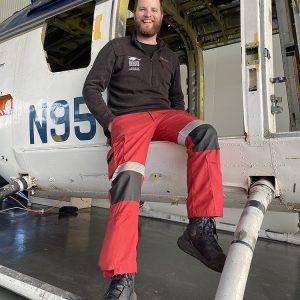THE Eastland Helicopter Rescue Trust hangar is one of the last bases in the North Island to get its own winch trainer but, to make up for lost time, the local team is going large.
“The other bases do have winch trainers, which are basically plywood cut-outs from where the crews and other emergency services can develop their skills in winch drops and lifts,” says Trust Tairāwhiti Eastland Rescue Helicopter critical care flight paramedic/base manager Richard Curtis.
“But we’ve been incredibly lucky to secure the shell of an actual BK-117 helicopter, which we’re able to adapt into this amazing piece of training equipment.”
Richard says having an on-site winch trainer will give more opportunities for upskilling, without having to take the helicopter up for every session.
“That’s important as a way of saving money, but also ensures our helicopter is on base and ready to respond to an emergency.”
The helicopter shell had been in storage at the Philips Search and Rescue Trust’s Taupo base until former Tairāwhiti base manager, Kelley Waite, secured it for Gisborne.
It arrived in Gisborne in early June and was moved on-site with the help of hangar neighbours, the Gisborne Aviation Preservation Society.
As with most things in the aviation industry, getting it up to standard for training is not going to come cheap.
However, local Sam Currie has offered his expertise and resources to help get the job done.
That requires him to do work on both the hangar and the shell, including designing and building a platform for access, and reconfiguring the interior to make it fit for purpose.
Richard says having a crew well-trained in winch use is critical as it has many applications in the field.
It can be used to winch a paramedic down if a patient is located far from a landing spot. It can be used to winch a patient up in a harness or stretcher (depending on their condition). And it can be used to recover bodies from inaccessible locations, bringing the deceased back to whanau with care and dignity.
“We’re also able to share our training facilities with other emergency responders to ensure they, too, can work with a winch if required,” he says.
“There are occasions when members of services like NZ Police need to come down on a wire so it’s good to be able to help with that, without having to take the helicopter up every time.”
The winch project is largely being funded by the Hume family who, after the sudden death of their daughter last year, asked mourners for a donation to EHRT in lieu of flowers.
“Nothing can make up for their loss but, even though their family member was not a patient of ours, they have provided equipment that could help save the lives of others,” says Trust chair Patrick Willock.
“It never ceases to amaze us how, even at their darkest times, people like the Hume family are thinking of how they can make a difference in our community.”
CAPTION: Trust Tairāwhiti Eastland Rescue Helicopter critical care flight paramedic Lachlan Clark with the BK-117 shell that is being converted to an in-hangar winch training tool.
Photo: File Photo
